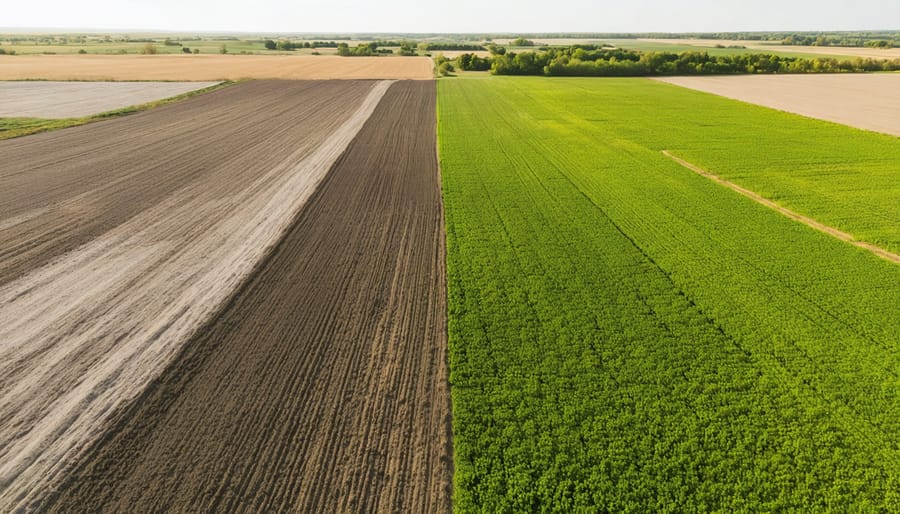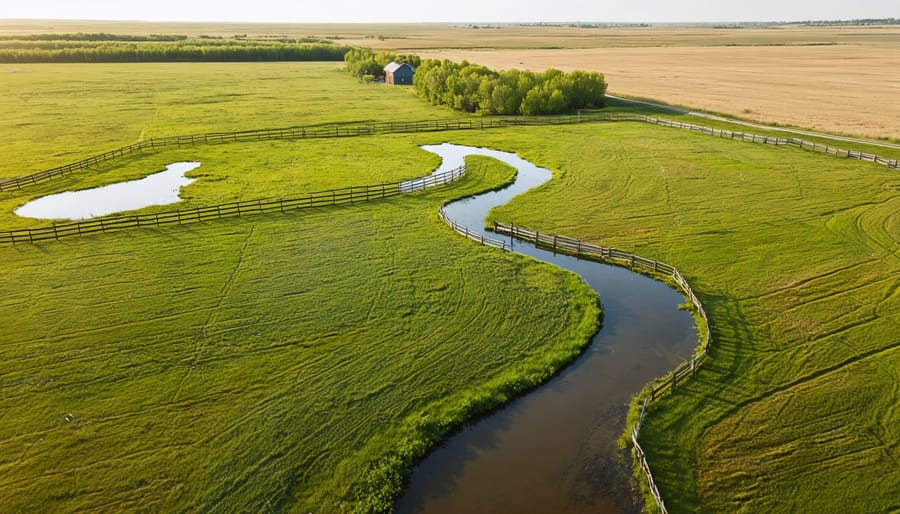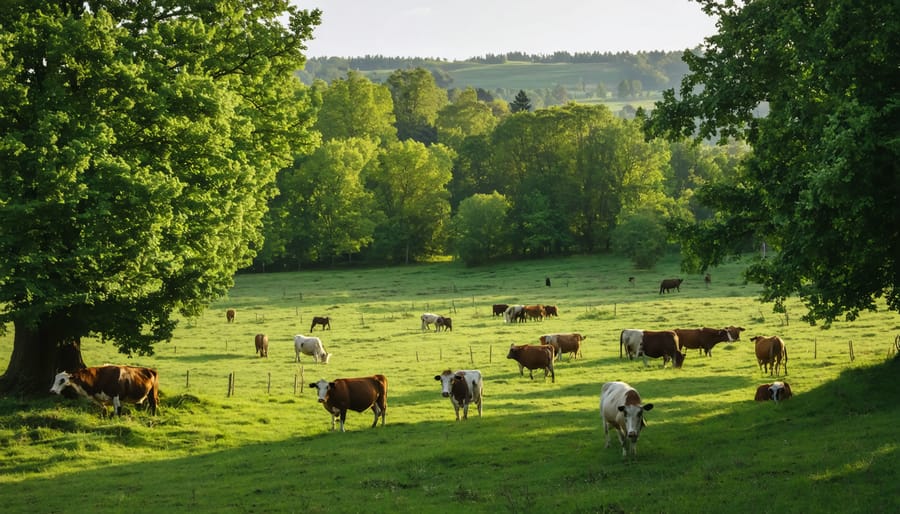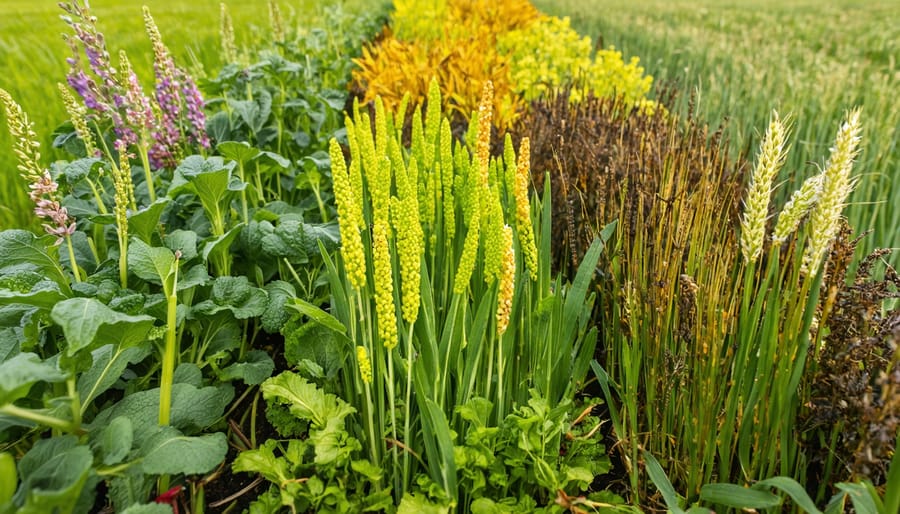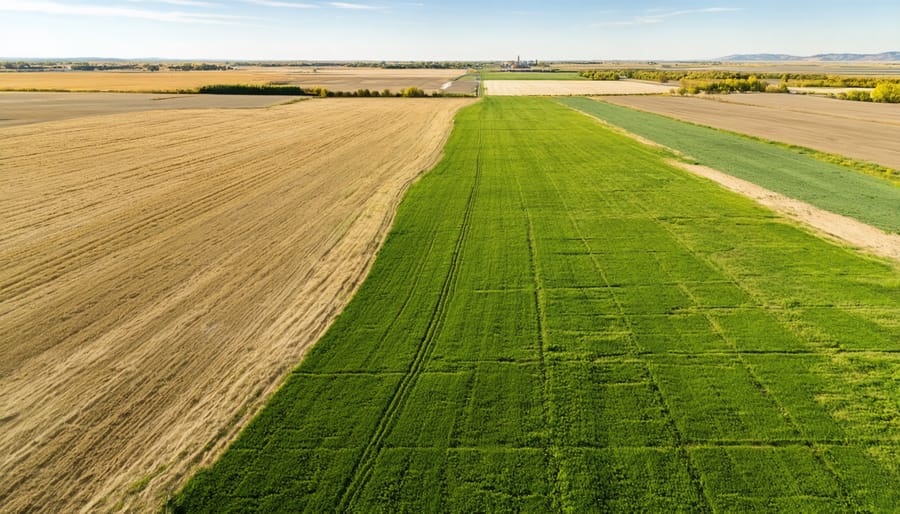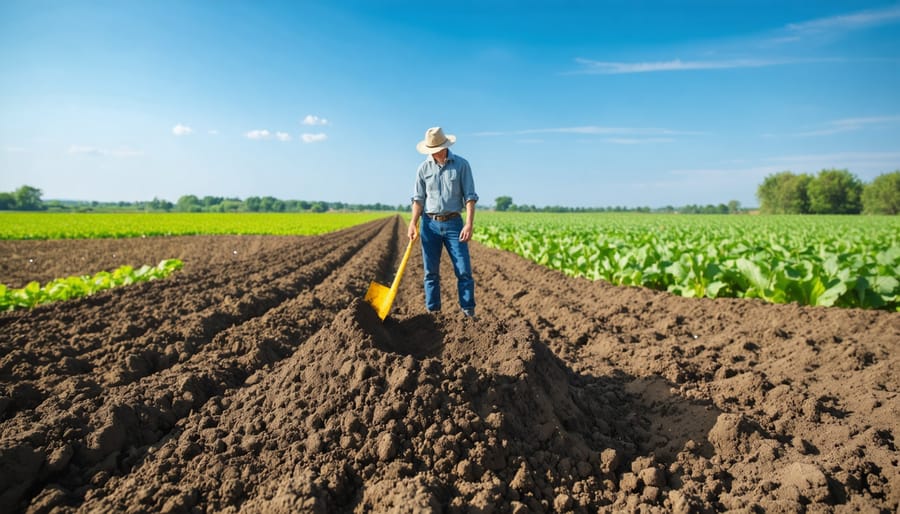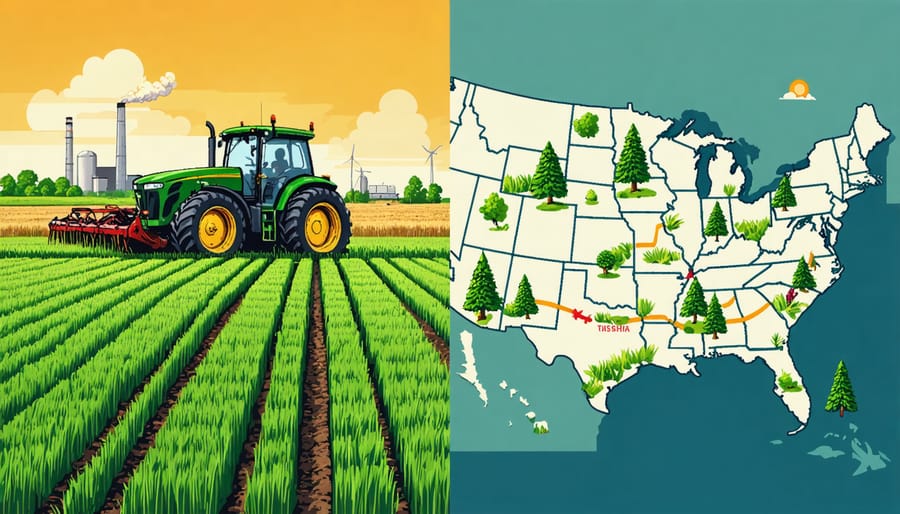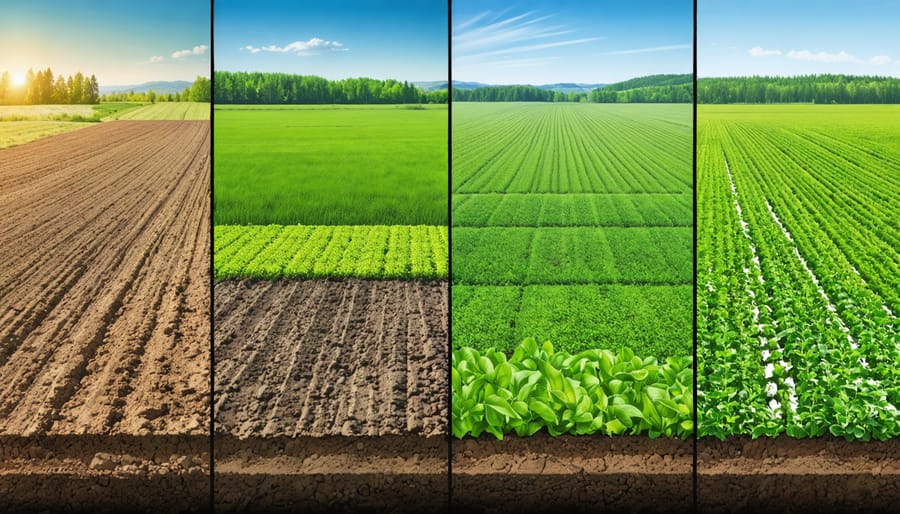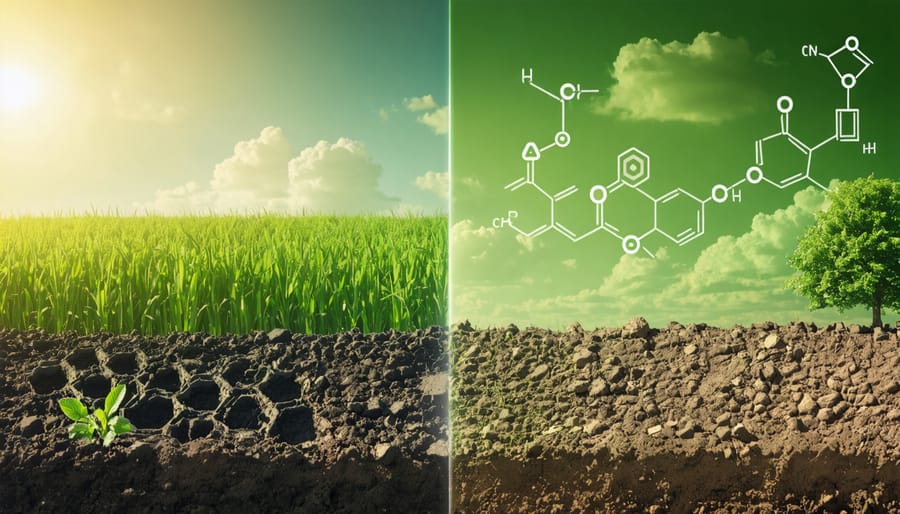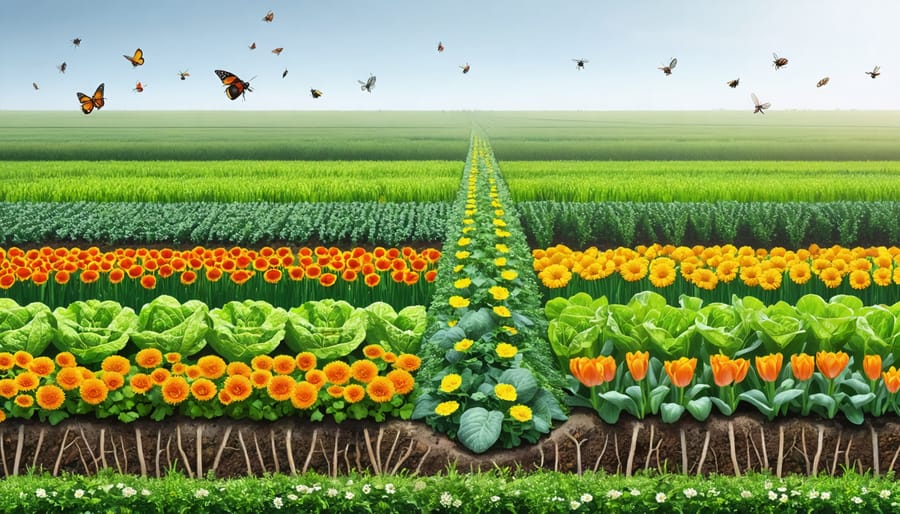Transform depleted farmland into thriving, productive soil by implementing strategic cover cropping, minimal tillage practices, and diverse crop rotations. Understanding soil health importance starts with measuring current organic matter levels, which directly influence water retention and nutrient availability across Prairie landscapes. Canadian farmers who adopt regenerative practices consistently report 15-30% increases in soil organic carbon within three to five years, while reducing input costs by an average of $75-100 per acre.
Regenerating soil demands a systems-based approach that works with natural processes rather than against them. From Alberta’s brown soil zones to Manitoba’s black soil regions, successful regeneration strategies must account for local climate conditions, existing soil composition, and available resources. The return on investment becomes evident through improved drought resilience, reduced erosion, and enhanced nutrient cycling – critical factors for sustainable agriculture in our changing Prairie climate.
Time-tested methods paired with modern soil science now offer Prairie farmers practical, cost-effective solutions to rebuild soil health while maintaining profitable operations. This comprehensive guide outlines proven strategies specifically adapted for Canadian growing conditions, backed by research from leading agricultural institutions and real-world success stories from local farmers.
Understanding Your Soil’s Current State
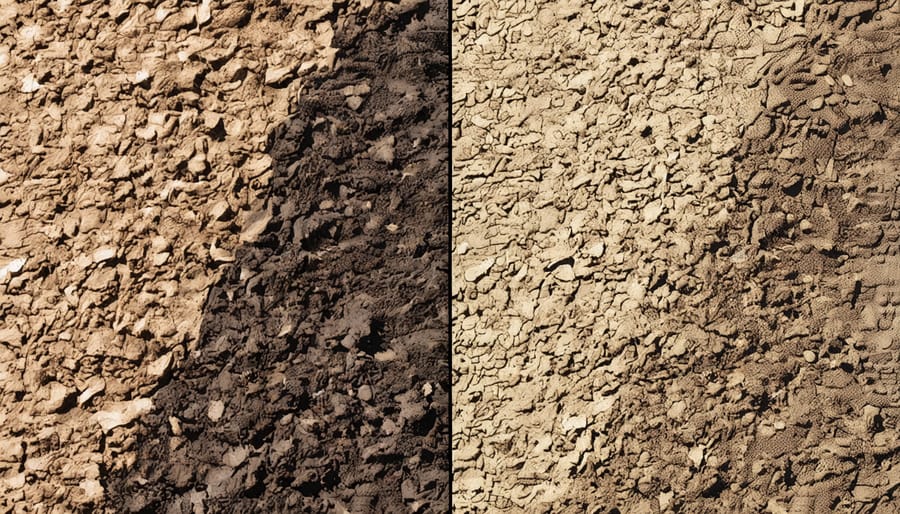
Essential Soil Tests for Alberta Farms
Regular soil testing is your foundation for successful soil regeneration in Alberta. Start with these essential tests: organic matter content, pH levels, electrical conductivity (EC), and available nutrients (N-P-K). Most Alberta soil testing labs offer comprehensive packages that include these basics plus micronutrient analysis.
For accurate results, collect soil samples in early spring or fall, taking cores from 0-15 cm depth across different field zones. Aim to test your soil every 2-3 years, though annual testing can be valuable during transition periods.
When interpreting results, pay special attention to your organic matter percentage – most productive Alberta soils range between 2-6%. A pH between 6.0-7.5 is ideal for most crops. For EC, readings below 2 dS/m indicate good growing conditions.
Local agronomists can help you understand your test results in the context of your specific region, whether you’re farming in the Black Soil Zone or dealing with Brown Chernozemic soils. Many Alberta agriculture offices offer free consultations to help farmers interpret their soil test results and develop improvement strategies.
Remember to keep your soil test records to track changes over time – this data is invaluable for measuring your regeneration progress.
Reading Your Land’s Warning Signs
Your land speaks through visible signs that indicate soil health problems. Watch for bare, crusty soil surfaces that crack easily, as these suggest poor soil structure and reduced water infiltration capacity. Standing water after rainfall points to compaction issues, while patches of stunted or yellowing crops often signal nutrient deficiencies.
Look for weed patterns too – an abundance of certain species like Canada thistle or quackgrass typically indicates specific soil imbalances. The presence of earthworms and beneficial insects, or their absence, tells you about your soil’s biological activity. After tilling, healthy soil should have a fresh, earthy smell and break apart easily into small, stable clumps.
During dry spells, watch how your crops respond. Fields with poor soil health typically show stress earlier than those with healthy soil structure. The colour of your soil matters too – darker shades usually indicate higher organic matter content, while pale, greyish soils might need attention. By regularly observing these indicators, you can spot problems early and adjust your management practices accordingly.
Core Regeneration Techniques
Cover Cropping in Cold Climates
In Alberta’s challenging climate, selecting the right cover crops requires careful consideration of our shorter growing season and harsh winters. Cold-hardy species like fall rye, winter triticale, and hairy vetch have proven particularly successful in our region, offering excellent soil protection during those critical shoulder seasons.
For best results, aim to seed your cover crops by mid-August to ensure adequate establishment before winter. Early-maturing varieties of field peas and oats can work well when planted after harvest, while winter cereals provide excellent spring growth and soil protection. Many local farmers have found success with cocktail mixes, combining cereals with legumes to maximize soil benefits.
Managing cover crops in our climate means working with nature’s timeline. Consider frost-seeding clover in early spring when soil is still experiencing freeze-thaw cycles. This technique allows seeds to work naturally into the soil surface. For fall-planted cover crops, allow them to grow until hard frost, typically around -5°C, which usually occurs in late October in most parts of Alberta.
Termination timing is crucial – plan to terminate spring growth at least two weeks before seeding your cash crop to prevent moisture competition. Some producers have successfully used winter-kill species like oats and spring cereals, letting nature handle termination and creating perfect spring planting conditions with minimal intervention.
Local success stories show that even in our shortest seasons, cover crops can significantly improve soil structure and organic matter content while protecting against erosion during our harsh winters.
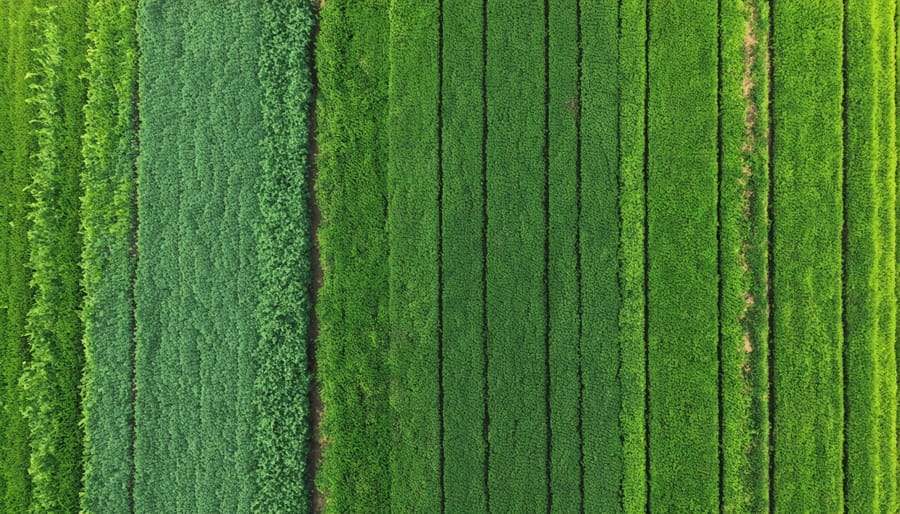
No-Till Practices That Work
Transitioning to no-till farming practices in Prairie conditions requires careful planning and the right approach. Start by leaving crop residue on your fields after harvest – this natural armor protects soil from erosion and helps retain moisture during our dry spells. For best results, invest in proper equipment like low-disturbance disc openers or knife openers that can handle heavy residue.
Consider implementing a diverse crop rotation that includes both warm and cool-season crops. In Alberta, successful rotations often include canola, wheat, and pulse crops like field peas or lentils. These varying root structures help break up compaction naturally and contribute different organic matter types to your soil.
Managing weeds becomes crucial in a no-till system. Start clean in spring using appropriate pre-seeding burn-off treatments, and consider using cover crops during shoulder seasons. Many Prairie farmers have success with fall rye or winter wheat as cover crops, which establish well in our climate.
Watch your timing carefully – seeding into cold, wet soils can be challenging without tillage. Wait for soil temperatures to reach at least 5°C and ensure proper seed placement depth. Use row cleaners to move excess residue and create an ideal seedbed environment. Remember, patience during the transition period is key – it typically takes 3-5 years to see the full benefits of no-till in our Prairie soils.
Crop Rotation Strategies
Effective crop rotation is a cornerstone of soil regeneration in Alberta’s diverse agricultural landscape. A well-planned three to four-year rotation pattern can significantly boost soil health while maintaining farm productivity. Start by incorporating nitrogen-fixing legumes like field peas or fava beans, which are well-suited to our Prairie climate and can add 50-80 kg of nitrogen per hectare to your soil.
For optimal results, follow legumes with heavy-feeding crops like canola or wheat, which can utilize the enriched soil. Include deep-rooting crops like alfalfa every third or fourth year to break up compaction and improve soil structure. These crops create natural channels for water infiltration and help bring nutrients up from deeper soil layers.
Many Alberta farmers have found success with the following rotation pattern: Year 1 – Legumes (peas/beans), Year 2 – Cereals (wheat/barley), Year 3 – Oilseeds (canola/flax), Year 4 – Cover crop mix. This sequence helps break pest and disease cycles while building organic matter.
Remember to adjust your rotation based on your specific soil type and local conditions. Sandy soils might benefit from more frequent cover cropping, while heavy clay soils might need additional deep-rooting crops. Consider including winter cereals in your rotation, as they provide excellent soil coverage during our harsh Prairie winters and help prevent erosion.
To maximize benefits, aim to keep living roots in the soil as long as possible during our growing season. This practice supports beneficial soil microorganisms and enhances overall soil structure.
Building Living Soil Systems
Compost and Organic Amendments
In Alberta’s diverse agricultural landscape, locally sourced organic materials are your soil’s best friends. Compost and organic amendments work wonders in rebuilding soil structure and boosting microbial activity. Start by identifying readily available materials in your area – livestock manure from neighbouring farms, crop residues, or even municipal leaf collections can serve as excellent base materials.
For optimal results, aim for a mix of both nitrogen-rich “greens” (fresh grass clippings, kitchen scraps) and carbon-rich “browns” (straw, dried leaves) in your compost pile. The ideal ratio is roughly 3:1 browns to greens by volume. In our Prairie climate, maintaining proper moisture levels is crucial – your compost should feel as damp as a wrung-out sponge.
Many Alberta farmers have found success with windrow composting, which works well for larger operations. For smaller plots, static pile composting is equally effective. Whatever method you choose, ensure your pile reaches internal temperatures of 55-65°C to kill weed seeds and pathogens.
When applying finished compost, target 10-15 tonnes per hectare for field crops. For intensive vegetable production, you might increase this to 20-25 tonnes per hectare. Remember to incorporate organic amendments in early spring or fall when soil moisture conditions are optimal.
Local success stories show that regular applications of quality compost can increase organic matter by 0.5-1% within 3-5 years, significantly improving your soil’s water-holding capacity and nutrient availability.

Supporting Soil Microorganisms
Supporting soil microorganisms is like nurturing an underground workforce that improves your soil naturally. Here in Alberta, we’ve seen remarkable success when farmers focus on feeding these beneficial organisms. Start by minimizing synthetic inputs that can disrupt microbial communities and instead opt for organic amendments like well-aged compost and manure.
Cover crops play a crucial role in supporting soil life. Local farmers have had great results with clover and vetch, which not only protect the soil but also provide food for microorganisms through root exudates. Consider leaving crop residues on your fields – they break down to feed beneficial fungi and bacteria while protecting the soil surface.
Adding diverse carbon sources is essential. Mix in different organic materials like straw, wood chips, and green matter. Many Alberta farmers are finding success with compost tea applications, which introduce beneficial microorganisms directly into the soil.
Avoid excessive tillage, as it disrupts fungal networks and bacterial communities. Instead, practice minimal soil disturbance and maintain soil moisture levels around 60% to create ideal conditions for microbial activity. During our cold winters, keeping the soil covered helps protect these valuable organisms.
Remember to monitor your progress by observing earthworm populations and doing simple soil tests. Many successful regenerative farmers in our region start small, testing these practices on a portion of their land before scaling up.
Making It Work Financially
Available Grants and Programs
Alberta farmers have several financial resources available to support their soil regeneration efforts. The Canadian Agricultural Partnership (CAP) offers grants up to $100,000 for environmental sustainability projects, including soil health initiatives. Through the Environmental Stewardship and Climate Change Producer Program, farmers can access funding for soil testing, cover crop implementation, and erosion control measures.
The Agricultural Research and Extension Council of Alberta (ARECA) provides cost-sharing opportunities for producers implementing regenerative practices. Their On-Farm Climate Action Fund covers up to 85% of costs for nitrogen management, cover cropping, and rotational grazing systems.
Local Agricultural Service Boards (ASBs) offer equipment rental programs and technical support at reduced rates. The Alternative Land Use Services (ALUS) program compensates farmers for converting marginally productive land into conservation projects that enhance soil health.
Results Driven Agriculture Research (RDAR) funds innovative soil management projects, offering grants between $50,000 to $250,000 for qualified initiatives. Contact your local agricultural fieldman or RDAR representative to learn more about application deadlines and eligibility requirements.
Calculating Return on Investment
Investing in soil regeneration practices can deliver significant financial returns over time. Studies across Alberta farms show that regenerative agriculture benefits typically become evident within 3-5 growing seasons, with some farmers reporting up to 25% reduction in input costs.
Consider these key financial metrics when calculating ROI:
– Reduced fertilizer costs (15-30% savings reported)
– Lower irrigation needs (20-40% reduction in water usage)
– Decreased pest management expenses
– Improved crop resilience and yield stability
– Premium prices for regeneratively grown products
Local success stories include the Davidson family farm near Red Deer, which recovered their initial $20,000 investment in cover cropping within two seasons through reduced input costs and improved yields. Their soil organic matter increased by 2%, leading to better water retention and reduced irrigation needs.
Track your ROI by maintaining detailed records of:
– Initial implementation costs
– Annual input reductions
– Yield changes
– Soil testing results
– Market premiums achieved
Remember that while some practices require upfront investment, the long-term financial benefits often outweigh initial costs through improved farm resilience and reduced operational expenses.
Regenerating soil health is a journey that requires dedication, patience, and a community-minded approach. As we’ve explored throughout this guide, the key to success lies in understanding your soil’s current condition, implementing appropriate regenerative practices, and maintaining consistent monitoring of progress.
Remember that every farm’s journey is unique, and what works for your neighbour might need adjustment for your land. Start small with test plots, carefully document your results, and gradually expand successful practices across your operation. The combination of cover cropping, minimal tillage, and thoughtful rotational grazing has already helped numerous Alberta farmers restore their soil’s vitality while maintaining profitable operations.
Your next steps should include conducting a comprehensive soil test, connecting with local regenerative farming groups, and developing a season-by-season implementation plan. Consider reaching out to Alberta’s agricultural extension services and joining soil health workshops in your area. Many farmers in our region have found success by partnering with experienced mentors who can provide guidance specific to our unique climate and conditions.
The investment in soil regeneration today will yield returns for generations to come. Not only will you see improved crop resilience and reduced input costs, but you’ll also be contributing to the long-term sustainability of Canadian agriculture. Together, we can build healthier soils that support both productive farms and thriving rural communities.
Remember, every positive change in soil health, no matter how small, is a step toward a more sustainable and profitable farming future.

